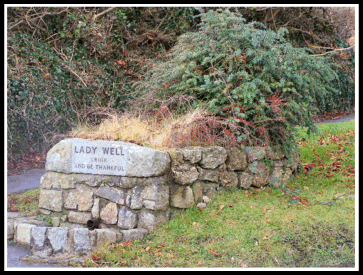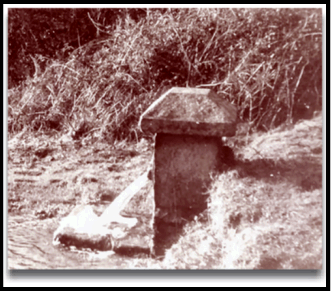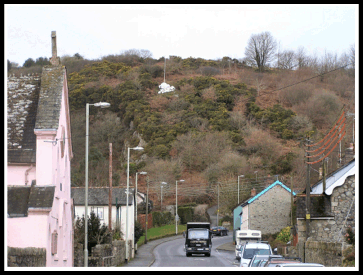
Firstly, the well, beside the old A30 road at the western end of the village of Sticklepath is the ‘Lady Well’. This small well consists of a small granite trough fed by a pipe, a large lintel-like boulder lies over the well with the inscription, “LADY WELL, DRINK, AND BE THANKFUL.” Court, 1927, p.203, describes the well thus:
“… just where the road leaves Sticklepath for Okehampton, there is a well of great antiquity, which has a granite head with an inscription, “Lady Well, Drink and be thankful,” and is known locally as the Lady-well. The stonework is so crude in its ornamentation that it has puzzled all the antiquarians; but its presence here is evidence that this road is one of the most ancient tracks of men in the West.“

The source of the well is a spring further up the opposite hillside in Allermead where the original well was located. In the book, The Story of Sticklepath the following is noted: “The source of this never-failing spring is rather further up the hill than the present Ladywell structure, in Alder Meadow (Allermead) on the opposite side of the road.”, p.17.
F. Jefferies, in 1862 notes the following: “The spring which supplies this fountain and the village below is conducted through pipes from its source in a little field, on the opposite side of the present road, described to us by a resident antiquary, Mr Pearce, (to whom the preservation of the well is due,) as “Our Lady’s Mead”.
The well had a constant trickle of water which fell in a pool that was about three inches in diameter and roughly four foot deep. The well was famed for never drying up and probably around 1820 a local woolstapler named John Pearse (noted above) had the overflow from the spring piped across the road to the present location of the well.

The original well
The water was collected in a tank which is secreted under the granite blocks. Old photographs of the present well show that the ‘lintel’ stone is not the original one as it had much cruder writing with the use of ‘&’ instead of the actual word and also two incised ‘x’s’ at each end, Greeves, 2004, p.89. In 1887 the water from the Lady Well was piped down the main street to various standpipes in celebration of Queen Victoria’s Jubilee. This meant that many of the ‘west-end’ residents no longer had to walk up to the end of the village to draw water. An electric pump was then installed in the well-house in order to carry water up to the village school which once again meant water didn’t have to be carried in buckets to the building. At one time, the waste water from the well was used to flush sewers on the north side of the village. There seems to be no reference to which ‘lady’ the well takes its name from or of any healing properties. Despite a possible medieval origin the well seems to have been a purely ‘functional’ water source.
Above the well on the steep hillside is a rock-pile that has been painted white and which has a flagpole standing from it. This is called the ‘White Rock’ and can be seen in the top centre of the photograph below, the well is just discernable by the black car ascending the hill:

The significance of this rock is that it is said to have been the place where noted Wesleyan preacher, John Wesley used to preach. As Sticklepath stands on what used to be the main route running through Devon into Cornwall it meant that he passed through on many occasions. Court, 1927, p.203, cites an entry from Wesley’s journal of 1743 when he writes;
“Sept. 22nd 1743 – As we were riding through a village called Sticklepath, one stopped me in the street and asked me abruptly, “Is not thy name Wesley?” Immediately, two or three came up and said I must stay there. I did so; and before we had spoken many words our souls took acquaintance with each other, I found they were Quakers; but that hurt me not, seeing the love of God was in their hearts.“
On April 1st, 1744, Wesley once again rode through Sticklepath and wrote in his journal, Court, p.204;
“… I rode to Sticklepath: at one, I preached in an open place on ‘This is the record, that God hath given to us eternal life, and this life is in His Son.’ A storm of hail and rain began when I was preaching, but the congregation did not move. At five I preached again. Many of the poor people followed me to the house at which I lodged, and we could not consent to part until we had spent another hour in exhortation and prayer and thanksgiving.“
At 5.00am the following morning he preached again and then left for Launceston following which he returned on the 17th and held another service before moving on to Crediton.
The “open space,” which Wesley said he preached at is thought to have been near the ‘White Rock’ which at the time would have stood beside the main ‘stickle‘ (steep) hill which was the main Devon to Cornwall road. Every year the White Rock has been given a new coat of whitewash to commemorate the visit of the great preacher. This was done on an April Sunday and was originally carried out by local Wesleyans but in the 1950’s the task was taken on by members of the Men’s Club and has since been carried out by the Sticklepath & Okehampton Conservation Group.
Reading List.
Court, L. H. 1927 Some Dartmoor Saints and Shrines, Morgan & Scott, London.
Greeves, T. 2004 Images of England – Dartmoor, Tempus Publishing, Stroud.
Rendell, P. 2003 John Wesley on Dartmoor, Dartmoor News – May & June, The Dartmoor Company, Okehampton.
Sticklepath W. I. 1993 The Story of Sticklepath, Private Publication.
 Legendary Dartmoor The many aspects past and present of Dartmoor
Legendary Dartmoor The many aspects past and present of Dartmoor
